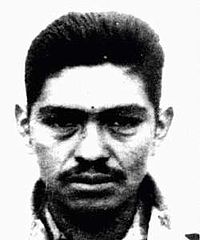
Simeon Cuba Sarabia
Encyclopedia

Che Guevara
Ernesto "Che" Guevara , commonly known as el Che or simply Che, was an Argentine Marxist revolutionary, physician, author, intellectual, guerrilla leader, diplomat and military theorist...
in Bolivia
Bolivia
Bolivia officially known as Plurinational State of Bolivia , is a landlocked country in central South America. It is the poorest country in South America...
. Born in the Cochabamba
Cochabamba
Cochabamba is a city in central Bolivia, located in a valley bearing the same name in the Andes mountain range. It is the capital of the Cochabamba Department and is the fourth largest city in Bolivia with an urban population of 608,276 and a metropolitan population of more than 1,000,000 people...
region of Bolivia, he became a leader among tin miners in Huanuni and served as the secretary of organization and secretary of militias of the local mine workers' union. He also carried out various social service activities for the benefit of the miners' families. Cuba Sarabia joined the Communist Party of Bolivia (PCB) but resigned from it in 1965 to become a member of the Bolivian Marxist-Leninist Party which favored armed struggle. When he urged that group to put its principles into practice, he was expelled from it along with Moisés Guevara. It was Moisés Guevara who brought him into Che Guevara's Ñancahuazú guerrilla group in March 1967.
Guerrilla Fighter
Selected to be a member of the "center" unit which was led by Che Guevara himself, Willy came to be known as a disciplined and courageous combatant. Despite this, and perhaps as a result of his extremely reserved nature, Guevara developed suspicions about him and in his monthly summary for September 1967 wrote in his campaign diary that "The morale of the rest of the group has remained quite good, and I only have doubts about Willy, that he may take advantage of some havoc to try to escape by himself ... " His suspicions would soon prove to have been unfounded.On 8 October 1967 when the guerrillas' final battle commenced in the Yuro Ravine, Willy was leading the "center" group as they tried to find a way to break out of the Army's encirclement. Willy was just at the point of clearing the steep wall of the ravine when Guevara, following some distance behind him, received a sudden blast of machine gun fire that wounded him in the leg. Willy turned around and went back down the cliff to where Guevara lay. He picked him up and carried him to a location out of the direct line of fire. However, the two guerrillas almost immediately found themselves surrounded by another group of rangers who opened fire against them; Guevara and Willy shot back at them until one of their bullets knocked Che's beret off his head and another disabled his M-2 carbine. Willy moved Guevara out of the line of fire again, then placed himself between his wounded leader and the rangers — who were now firing at them from a distance of less than ten yards — and began to return fire. In this exposed position, Willy was struck almost instantaneously by a hail of bullets and incapacitated. A group of rangers rushed forward, demanding their surrender. Seeing the soldiers approach Guevara, Willy confronted them and shouted, "This is Comandante Guevara. Show him respect!"
Execution
The rangers took Guevara and Willy to the nearby village of La Higuera where they were imprisoned overnight in separate rooms of a small adobe schoolhouse. The next day, after the order issued by Bolivian President René BarrientosRené Barrientos
René Barrientos Ortuño was a Bolivian politician who served as his country's Vice President in 1964 and as its President from 1964 to 1969....
that they should both be killed had been confirmed, the commanding officer sent an execution squad consisting of three soldiers into the schoolhouse. The soldiers entered the room where Willy was being held first and riddled him with several bursts of machine gun fire. Before dying, Willy managed to cry out, "I am proud to die next to Che!" These were probably the last words Che Guevara heard, because he was executed in similar fashion only a few seconds later.
The Bolivian Armed Forces refused to give information about what had been done with Cuba Sarabia's remains. Almost thirty years after his death, on 28 June 1997, a Cuban forensic team discovered his skeleton in the same burial pit situated on the auxiliary runway of the Vallegrande
Vallegrande
Vallegrande is a small colonial town in Bolivia, located in the Department of Santa Cruz, some 125 km southwest of Santa Cruz de la Sierra. It is the capital of the Vallegrande Province and Vallegrande Municipality and serves as a regionally important market town...
airport that contained the remains of Che Guevara and five other guerrillas. Willy's remains were transferred to Cuba along with those of Guevara and the five other combatants and, on 17 October 1997, their caskets were laid to rest with full military honors in the Che Guevara Mausoleum in the city of Santa Clara
Santa Clara, Cuba
Santa Clara is the capital city of the Cuban province of Villa Clara. It is located in the most central region of the province and almost in the most central region of the country.- History :Santa Clara was founded by 175 people on July 15th, 1689...
.
Content Notes
External links
- Photo of a mural in Huanuni depicting Willy and Che Guevara
- More photos of Huanuni
- A day in the life of a mine worker in Huanuni
- Members of Che Guevara's Guerrilla Movement in Bolivia - by the Latin American Studies Organization

